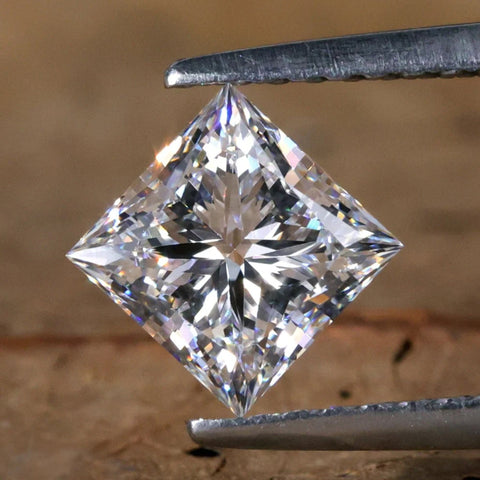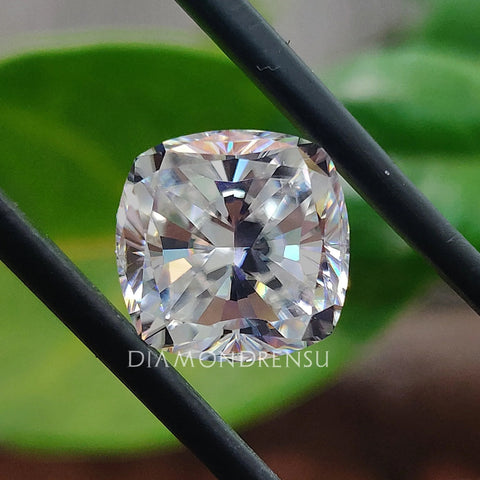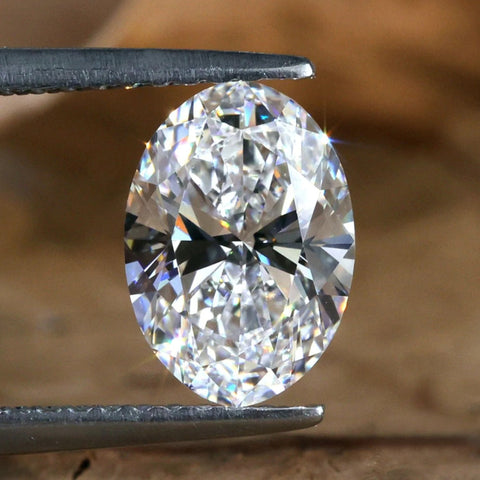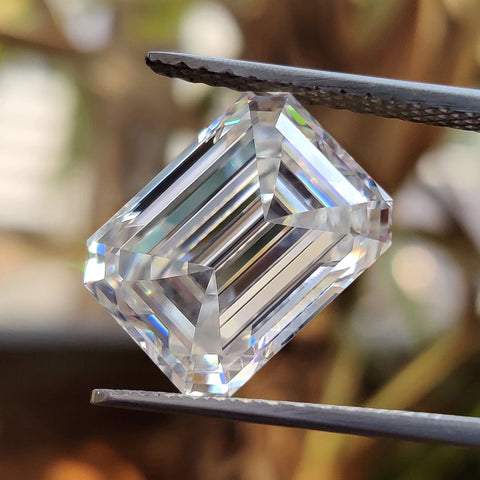
Moissanite vs. Lab Grown Diamond: Which One Is Right For You?
Table Of Contents
- Lab-created diamonds and moissanite history
- What is a Moissanite vs lab-grown diamond?
- How is moissanite formed versus how lab-grown diamonds are formed?
- What is the major difference between moissanite and lab-grown diamonds?
- Moissanite vs. Lab-Grown Diamonds: A Comparison
- Which one is right for you?
- Conclusion
Moissanite and lab-grown diamonds are not the same things. Moissanite vs lab-grown diamond is critical to understand their distinctions. Today, conscientious consumers have a plethora of mined-diamond alternatives to choose from. It is common to confuse moissanite vs lab diamond simulants with lab-grown diamonds. Those looking for sustainable, ethical, or cost-effective alternatives must exercise caution when conducting their research.
Lab-created diamonds and moissanite history
Did you know that over 300 gemstones have been discovered throughout history? Also, did you know that diamond is one of the oldest gems discovered, whereas moissanite is one of the most recent?
Natural diamonds were first discovered by humans in Indian caves between 4 and 6 B.C. Moissanite, on the other hand, was discovered by chance by Henri Moissan. What about learning about the history of the moissanite lab-created gem, which is thought to be an excellent substitute for a lab-grown diamond? In 1893, a French scientist named Henri Moissan travelled to the Arizona desert to investigate a meteorite crash. The extraterrestrial object had crashed there thousands of years before, leaving a large crater in its wake.
Princess Cut Diamond, Loose 1 Carat Princess Cut Lab Grown Diamond
Moissan had hoped to find materials that could be used to make crystalline chemical compositions with high electrical conductivity. However, he came across a remarkable and extremely rare object by chance and collected it, mistaking it for a diamond piece.
Back in the lab, scientists examined the object and discovered silicon carbide, a remarkable and rare mineral. A few years later, they'd figure out how to make a perfect gemstone out of it, naming it "Moissanite" after Dr Henri Moissan.
Today, the lab-created gem is almost as valuable as a lab-grown diamond. This is due to its gleaming appearance, durability, and lower price tag.
What is a Moissanite vs lab-grown diamond?
Lab-grown diamonds are chemically and structurally identical to natural diamonds, except being produced using highly specialised technology, equipment, and responsibly sourced raw materials. Both lab-grown diamonds and moissanite are created in dedicated facilities and are appealing, cost-effective options for people looking for non-mining stones.
Moissanite, which is made of silicon carbide, is frequently used as a diamond substitute due to its durability, sparkle, and low cost.
How is moissanite formed versus how lab-grown diamonds are formed?
Because they are created from a natural diamond seed, lab-grown diamonds are structurally, chemically, and visually identical to natural diamonds. The only difference is that they are made in specialised facilities using complex processes like CVD (Chemical Vapor Deposition) or High-Pressure High Temperature (HPHT).
3.67 CT Cushion Cut Colorless Loose Moissanite for Engagement Ring
Moissanite is a mineral formed on Earth from silicon carbide. To create the brilliant gemstone, the naturally occurring process is replicated in a lab by combining heat and pressure. Only experts can tell the difference between lab-created and natural moissanite and answer the question, "Is moissanite lab-created?"
What is the major difference between moissanite and lab-grown diamonds?
Moissanite vs lab diamonds have similar properties to natural diamonds but are typically less expensive. While the appearance of these two stones may be similar, they differ in brilliance, durability, colour, and price.
Durability
Gemstones are graded on the Mohs Scale of Hardness to determine their resistance to surface scratching. Moissanite gems have a Mohs scale rating of 9.25, while lab-grown diamonds have a rating of 10. Both scores are excellent, indicating that each stone is suitable for everyday use in engagement rings and fine jewellery.
Brilliance
Moissanite vs lab-grown diamond gems has a different type of brilliance than lab-grown diamonds due to their different faceting pattern. Their blazing rainbow flashes reflect the entire colour spectrum. Moissanite has a refractive index of 2.65-2.69, which is more than twice that of natural diamonds. A lab-grown diamond, on the other hand, reflects light in more complex ways, including brilliance, dispersion, and scintillation, which gives the stone its legendary radiance.
Colour
Lab-grown diamonds, like natural diamonds, can vary in colour. They are graded using the same internationally recognised standards used to grade natural diamonds (D–Z, colourless to light yellow or brown). Moissanites are not graded on the diamond colour grading scale, but they frequently fall within the same colour range. Moissanite gems used in fine jewellery can be colourless, near-colourless, or coloured.
Price
While lab-grown diamonds are less expensive than natural diamonds, their prices vary depending on the shape, carat, cut, colour, and clarity. Moissanite gemstones are considerably less expensive than natural and lab-grown diamonds, with prices varying according to size, colour, and clarity.
Moissanite vs. Lab-Grown Diamonds: A Comparison
Personal preference and priorities play a role in deciding between moissanite and lab-grown diamonds. Here are a few of the key facts to be considered while deciding upon the choice between what is right for you-
Appearance: Lab-grown diamonds vs Moissanite are both visually stunning and can appear to be natural diamonds. They do, however, differ in appearance due to their different optical properties. Moissanite is famous for its rainbow-coloured light flashes, whereas lab-grown diamonds have the same clarity and sparkle as natural diamonds.
Durability: Moissanite vs lab-grown diamonds are durable and suitable for everyday wear, but lab-grown diamonds are slightly harder and more scratch resistant than moissanite.
Price: Moissanite is typically less expensive than lab-grown diamonds, which are priced similarly to natural diamonds. If you're looking for a low-cost diamond substitute, moissanite might be the way to go. Moissanite is one of the most cost-effective diamond substitutes on the market today. It costs one-tenth the price of a mined diamond. Moissanite prices vary according to size and the distinction between Premium and Super Premium colour grading.
Ethics: Some people prefer lab-grown diamonds to moissanite because they are produced in a controlled environment without the environmental and ethical concerns that come with diamond mining.
Rarity: While moissanite is a rare mineral, lab-grown diamonds are widely available and can be produced to exact specifications, making them an excellent choice for those seeking a specific size or colour of the diamond.
Sparkle or shine: What some call "sparkle" in a gemstone is better described as fire, brilliance, and scintillation. Moissanite typically has more fire and brilliance than diamonds or most other gems. This means that it appears to sparkle more than a diamond. Moissanite is doubly refractive and is cut differently to emphasise its overall radiance. However, the extra radiance does not imply that it is as durable or valuable as a diamond.
1.50 CT Oval Cut Diamond, Loose Lab Grown Diamond for Engagement Ring
In the end, the decision between Lab-grown diamond vs moissanite comes down to personal preference and what is most important to you. If you're looking for a low-cost option, moissanite may be the way to go, but lab-grown diamonds may be a better option if you're looking for a more sustainable and ethical alternative to natural diamonds.
Lab-grown diamonds vs Moissanites and lab-grown diamonds are disrupting the traditional diamond market, as many buyers are shifting their attention to these lab-produced gemstones.
Which one is right for you?
Moissanite is a laboratory-created gemstone with a high refractive index and the ability to emit more "fire" or colour than a diamond. It is also less expensive than diamonds, making it a popular choice for those who want the look of a diamond but not the high price tag.
In contrast, lab-grown diamonds have the same chemical composition and physical properties as natural diamonds, making them virtually indistinguishable from natural diamonds. They are also more ethical and environmentally friendly than natural diamonds because they are grown in a lab rather than extracted from the earth.
19.29 CT Emerald Cut Colorless Moissanite, Loose Moissanite for Custom Engagement
The final decision between moissanite and lab-grown diamonds is based on personal preference, budget, and intended use. If you value a diamond's traditional status and are willing to spend more, a lab-grown diamond may be a better option. However, if you want an inexpensive alternative with a lot of sparkles, moissanite may be the way to go.
Conclusion
Under this Moissanite vs lab-grown diamond moissanite and sustainable diamonds are less expensive and more environmentally friendly than natural diamonds, hence both are worth to be purchased. Despite this, they both appear more beautiful in many cases than natural diamonds. For this reason alone, for many of you on a tight budget, a lab-grown diamond or moissanite can provide more bang for your buck.
I hope this article helped you discover the similarities and differences between moissanite vs lab-created diamonds vs natural diamonds. For more details visit our website Diamondrensu.
Leave a comment
Please note, comments must be approved before they are published.













